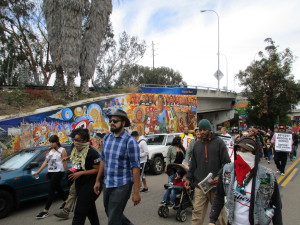 On April 10, 1919, revolutionary leader and hero Emiliano Zapata was ambushed and killed by counter revolutionary forces.
On April 10, 1919, revolutionary leader and hero Emiliano Zapata was ambushed and killed by counter revolutionary forces.
Zapata was assassinated for his commitment to the principles of the revolution. He fought for the implementation of El Plan de Ayala, which called for the expropriation of land and resources that were held by the bosses and landlords of Mexico. This elite class was supported by former leader of the Mexican Revolution Francisco Madero.
On Saturday April 9, community members, students, teachers and workers all came together to carry on the legacy of Emiliano Zapata by marching through the streets of Barrio Logan and returning to Chicano Park where the march began.
This annual event that is lead and organized by Somos Raza, Union del Barrio and Movimiento Estudiantil de Aztlan (M.E.Ch.A.) has been growing in more recent years. This year’s march also addressed the issue of gentrification that is taking place currently in Barrio Logan. This issue is one that has been gaining attention recently as more and more developers are purchasing property along Logan Ave. Community members marched down Logan Ave. to remind investors that the community is aware of their efforts and is making its voice heard. Marchers chanted proudly “Se ve, se siente, el pueblo esta presente” (You can see and feel us, the people are present). They also carried signs, banners and flags denouncing gentrification, capitalism and promoting the legacy of Emiliano Zapata.
The march ended with a celebration, speeches and a nationalist salute in Chicano Park where a statue has been erected in honor of the fallen hero Zapata.
It will take a people’s movement to end the process of gentrification. This movement must also include a high level of organization lead by residents, artists and small business leaders of the community. Attempting to organize in an environment with increasing pressure from outside investors and conflicting self-interest from within the community will make it difficult to navigate the various challenges facing this historically working class community of Chicana/o and Mexicana/o residents.
However, with a clear class analysis of the situation, we can see beyond the attempts to stop gentrification with neoliberal economic approaches that seek to use people of color to develop the area to make it more attractive to outsiders. This approach only serves to use educated, business or artistic sectors of the community to open the door for those with real wealth, power and resources to develop the area to increase property value for their financial profit.
For Logan to prosper, the residents need to be the owners of the storefronts and homes in the community. The residents need to have the decision making power to decide what gets built and what gets developed in order to meet the communities needs not investors who seek to fatten their bank accounts. Only a working class people’s movement can determine the needs of the community and maintain the cultural/historical legacy of Barrio Logan. Together we can win!
¡Viva Zapata y Viva la Revolución!





